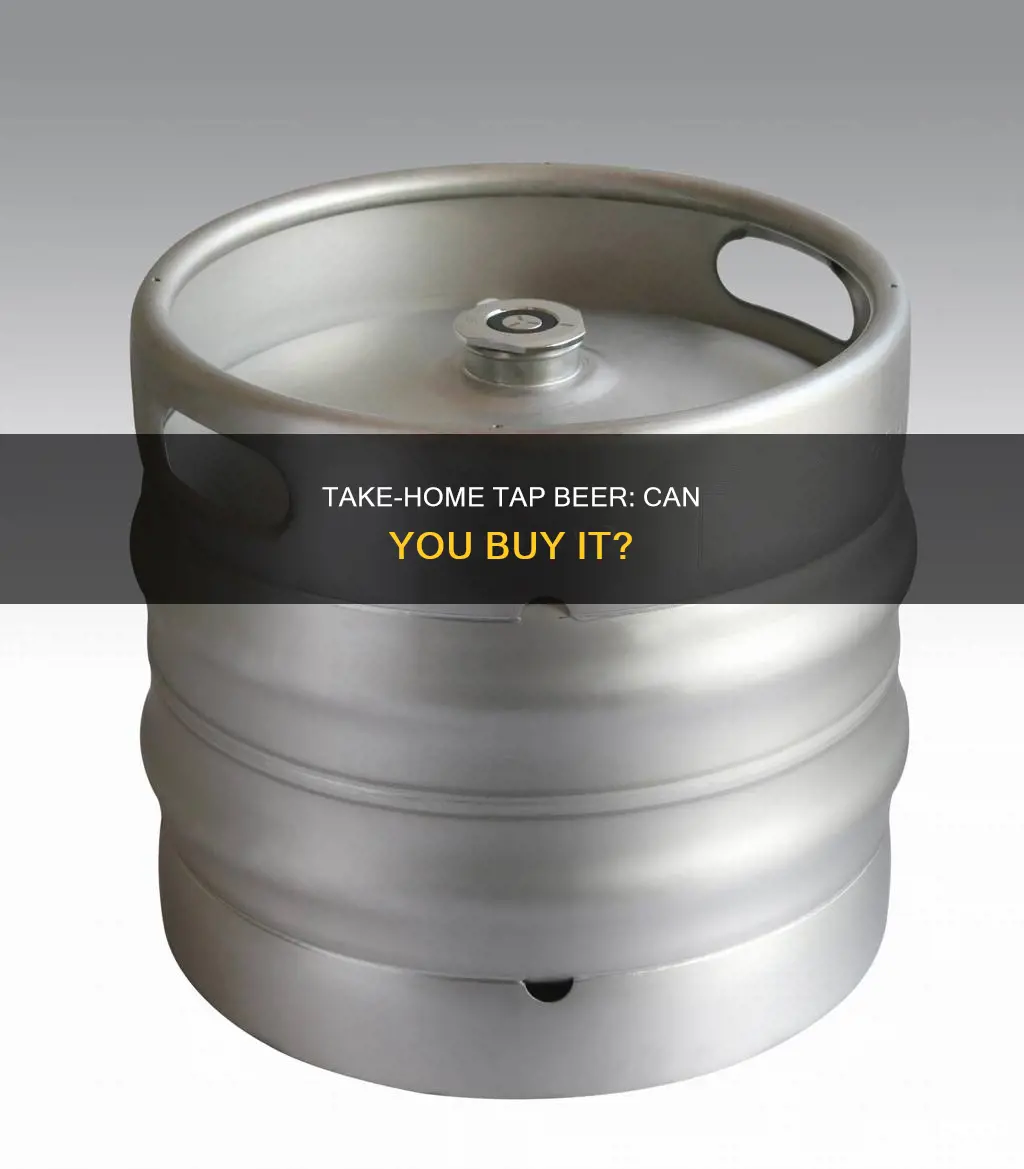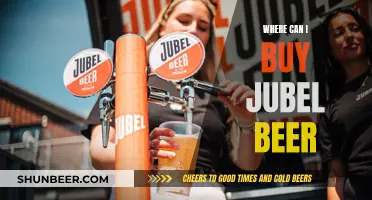
Beer lovers, listen up! If you're looking to take your favourite brew home with you, then you're in luck. There are a few options for transporting tap beer in containers, each with its own pros and cons. The most popular option is the trusty growler – an airtight jug typically made of glass, ceramic or stainless steel, which keeps your beer fresh during transport. You can also find beer dispensers, mini kegs and bottling buckets online or in specialty stores. So, whether you're a homebrewer, a craft beer enthusiast, or just looking to bring some tap beer to a party, there's a container option out there for you!
| Characteristics | Values |
|---|---|
| Container type | Growlers, kegs, bottles, cans |
| Container material | Glass, ceramic, stainless steel, cardboard, plastic, metal, acrylic |
| Container capacity | 12 oz, 16 oz, 17 oz, 40 oz, 64 oz, 128 oz, 10L, 2.6 gallons, 5 gallons, 15.5 gallons, etc. |
| Container features | Airtight, insulated, with/without taps, with/without CO2 canisters, with/without handles |
| Container use | Transporting, storing, serving, sharing, selling beer |
| Container cleaning | Rinse with hot water, use non-oil-based detergents, scrub with brush, air dry |
What You'll Learn

Growlers: containers for transporting draft beer
Growlers are containers designed for the transport of draft beer, typically made from glass, ceramic, or stainless steel. They are airtight, allowing you to take draft beer from one place to another without a degradation of quality.
Growlers come in various types, including glass, stainless steel, and ceramic. Glass growlers are the most popular and widely available, offering visibility into the filling process and the amount of beer remaining. However, they are fragile and can crack, chip, or shatter if handled carelessly. Stainless steel growlers are durable, easy to carry, and effective at keeping beer cold for extended periods. On the other hand, ceramic growlers are aesthetically pleasing but tend to be heavy and challenging to clean.
Growlers offer several benefits, including being an easy way to transport draft beer while keeping it fresh. They enable you to bring home beer from local breweries, share your homebrew with others, and ensure a continuous supply of beer at parties or bars when a keg is running low.
When using a growler, it is important to keep it at a desirable temperature, avoid overfilling, and inspect it for any chips, cracks, or dents before filling. Additionally, proper cleaning and sanitization are crucial to maintaining the beer's quality and preventing the growth of mold or other contaminants.
Growlers are a great option for beer enthusiasts who want to enjoy fresh draft beer away from the source, whether at home, outdoors, or with friends.
Lowenbrau Beer: Available in the United States?
You may want to see also

Glass, ceramic or stainless steel? Choosing your growler
When it comes to choosing a growler, there are a few factors to consider. The three most common types of growlers are glass, ceramic, and stainless steel. Each has its own advantages and disadvantages, so it's important to select the one that best suits your needs.
Glass growlers are the most common type and typically come in two styles: amber and clear. The main advantage of glass growlers is the visibility they offer, allowing you to see how full the growler is and when a refill is needed. Amber growlers are better at keeping beer fresh as they block out more light than clear growlers. However, clear growlers need to be stored away from direct sunlight to prevent the beer from spoiling. The main downside of glass growlers is their fragility; they can crack, chip, or shatter if not handled carefully.
Ceramic growlers are aesthetically pleasing and tend to be very durable. They are easy to carry around and are less likely to break if dropped, making them a good option for outdoor activities. However, they can be heavy to carry and more difficult to clean than other types of growlers. Ceramic growlers are also susceptible to chipping and breaking if handled carelessly.
Stainless steel growlers are becoming increasingly popular due to their portability and ability to keep beverages cold for longer periods. They are vacuum-insulated, which allows them to maintain the desired temperature for hours. This makes them ideal for travelling and outdoor activities. Additionally, stainless steel growlers are more durable than glass growlers and are less likely to crack or shatter. However, one downside of stainless steel growlers is the lack of visibility, which can make it challenging to fill and know when the beverage level is low.
In conclusion, the choice between glass, ceramic, or stainless steel growlers depends on individual preferences and specific needs. Glass growlers offer visibility but are more fragile, ceramic growlers are durable but can be heavy, and stainless steel growlers provide excellent temperature control and portability. Consider your intended use and choose the growler that best suits your drinking experiences.
Can Non-Residents Legally Purchase Beer in Texas?
You may want to see also

How to clean your growler
A beer growler is a container used to transport beer, usually from a brewery or bar to your home. It's important to keep your growler clean to ensure the best taste and avoid bacteria growth. Here are some detailed steps on how to clean your growler:
Step 1: Rinse with Hot Water
As soon as you finish drinking the beer, rinse your growler with hot water. Filling and swirling the hot water inside the growler and rinsing it out a few times will help remove any residue. If you can't clean it right away, store the growler in a cooler or the fridge to limit bacteria growth until you have time to wash it.
Step 2: Use a Cleanser (Optional)
If your growler has been sitting for a while and needs a deeper clean, you can use a cleanser. Avoid using dish soap or detergents as they can be difficult to rinse out completely and may leave a residue that affects the beer's head retention. Instead, opt for unscented cleansers like PBW, OxiClean, or bleach. Fill the growler with water and add a small amount of the cleanser, then rinse thoroughly. Make sure to rinse multiple times to ensure no cleanser residue is left behind.
Step 3: Scrub with a Brush (Optional)
If there is stubborn residue inside the growler, you can use a soft-bristle brush to scrub the inside gently. Avoid using metal wire brushes on glass or ceramic growlers as they can cause damage.
Step 4: Air Dry Upside Down
After rinsing and optional scrubbing, let the growler air dry completely. Place it upside down to facilitate drying and ensure no water is trapped inside. Do not cap the growler during the drying process as stagnant air inside can promote bacteria growth.
Step 5: Sanitize Before Refill
Before taking your growler to be refilled, ensure it is thoroughly clean and dry. Some establishments may offer to sanitize it for you, but it's always good to bring in a clean growler to avoid any issues.
Braxton Brewery: Beer to Go?
You may want to see also

Where to fill your growler
Growlers are containers that allow you to transport draft beer from one place to another without a degradation of quality. They are usually made out of glass, ceramic or stainless steel and are airtight.
The Growler Guys, Oregon
The Growler Guys is a growler fill station in Bend, Oregon, with 45 varied local craft beer favourites and not-so-local brews on tap. You can choose from either a 32-oz or 64-oz growler to take home. The Growler Guys now have locations across several states.
Cafe Centraal, Milwaukee
Cafe Centraal is known for its Euro-influenced menu and elegant patios. However, it also takes its beer seriously. You can fill your growler with Centraal Quadder, which Lowlands makes in partnership with Amherst, Wisconsin's Central Waters. You can also bring your own growler.
Camino, Milwaukee
Camino has become a favourite in Walker's Point for its pub fare and impressive beer list. It has 20 beers on tap that you can fill your growler with. You can bring your own or buy one of theirs.
Company Brewing, Milwaukee
Company Brewing brews its own beer, which is available on-site and in growlers and "crowlers" (a portmanteau of "can" and "growler"). Most growler fills run between $12 and $15, with discounts offered on Thursdays.
Draft & Vessel, Milwaukee
Draft & Vessel has 16 draft lines that you can sample before you decide what you want to take in your growler.
Fresh Thyme Farmers Market, Milwaukee
You can pick up some groceries and stop by the Growler Bar, a filling station and coffee house. They have about 10 beers on tap, and on Thursdays, you get $1 off a growler fill.
G. Groppi Food Market, Milwaukee
This Bay View staple is a bakery, deli, caterer, and more. They have a bar in the back where you can fill your growler with anything on tap.
Riverwest Filling Station, Milwaukee
Show them some love, as they helped get growlers legalised in Milwaukee. They have 30 draft beers to choose from.
The Growler Station, Lake Forest, California
The Growler Station is a craft beer filling station with independently owned and operated affiliate partners, ensuring you receive a unique experience at each location. Affiliates using the Pegas Counter Pressure Fill Technology ensure better-tasting and longer-lasting beer.
Buying Beer in Brazoria County: Sunday Shopping Laws
You may want to see also

Draft beer equipment for home and commercial use
There are several pieces of equipment required to dispense draft beer at home or commercially. The setup will depend on the scale of your operation, the distance from the keg to the dispenser, the number of beers and styles you plan to offer, and your budget. Here is an overview of the equipment you will need and some options to consider:
Kegs
Kegs are the containers that hold and store the beer. They come in various sizes, typically ranging from 10 to 50 liters. You can choose between stackable and non-stackable kegs, and there are different types of fittings and taps to consider, such as D-type Micromatic fittings.
Kegerators
A kegerator is an excellent option for small bars or home use. It is a refrigerated unit that houses the keg and dispenses beer through a tap system. Kegerators are usually designed to fit under a counter and can hold one or more kegs, depending on their size. They are often customizable and can be branded with logos or other designs.
Draft Faucets
Also known as taps, draft faucets are an essential component of any draft beer system. They come in various styles and materials, such as stainless steel or brass. When choosing a draft faucet, consider the pouring needs and the number of beers you plan to offer.
Beer Towers
Beer towers are an attractive way to dispense beer and can accommodate multiple taps. They are often countertop-mounted and can be customized with brand medallions or other designs.
Drip Trays
Drip trays are placed under the taps to catch any spills or overflow during the pouring process. They can be wall-mounted or placed on a countertop, depending on the setup. Drip trays come in various sizes and can include a side rinser for added convenience.
Jockey Boxes
Jockey boxes are ideal for outdoor events and parties as they provide a portable solution for dispensing draft beer. They typically consist of a cooler with ice and coils to chill the beer and one or more taps for dispensing.
Keg Pumps
Keg pumps are another option for outdoor dispensing. They are a simple and cost-effective way to pour draft beer outside, although they may not provide the same level of temperature control as other methods.
Glycol-Cooled Remote Beer System (Long-Draw)
This system is suitable for long-draw dispensing setups, typically running 25 feet or longer. It uses glycol to maintain the beer's temperature and ensure cold beer is delivered over long distances. This system is more complex and expensive but offers flexibility in equipment placement.
Air-Cooled Beer System
Air-cooled systems use circulating cold air to keep the beer cool. They are a less expensive option for short-draw draft systems and are commonly used by beer enthusiasts or small restaurants.
Direct Draw Beer System (Short-Draw)
The direct draw system is the most common and straightforward option for bars with the keg located within a few feet of the dispensing faucet. It is another cost-effective alternative to glycol chilling and minimizes beer waste due to the short length of the beer lines.
When designing your draft beer system, it is essential to work with professionals to ensure proper installation and maintenance. Additionally, regular cleaning of the equipment, especially the beer lines and faucets, is crucial to maintaining the quality of your draft beer.
Last-Minute Beer Runs on New Year's Eve: What's Open?
You may want to see also
Frequently asked questions
A beer growler is a container, typically made of glass, ceramic, or stainless steel, used to transport draft beer from one place to another without compromising its quality.
Beer growlers are easy to carry, transport, and fill. They are airtight, ensuring the beer remains fresh during transportation. Growlers are also a great way to sample a beer without committing to an entire keg.
It is important to clean your growler after each use. Rinse it with hot water immediately after pouring the last of your beer. If there is residue, use a non-oil-based cleanser and, if needed, a brush to scrub the inside. Let the growler air-dry.
You can fill your growler at breweries, bars, or pubs that offer this service. When filling, ensure the bartender uses the correct method to avoid too much foam and wastage. The bottom-up filling method is traditional but can increase oxygen in the growler, causing the beer to go stale faster.
An over-filled or over-pressurized growler may explode under extreme circumstances, such as very hot or cold temperatures. Always keep your growler at a desirable temperature, do not overfill it, and inspect it for any chips or cracks before filling.







